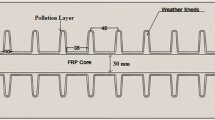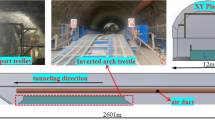Abstract
Under the condition of contamination and damp, the metal bolts on the composite tower become float potential conductor. Serious partial arc discharge appears near the metal bolt, which threatens the safe operation of the transmission line. The artificial pollution test is carried out on the small size specimen to reproduce the discharge phenomenon and obtain the characteristic parameters. Based on the parameter optimization method with infrared temperature data as constraints, the distributed parameter finite element model of the specimen is calculated to obtain the electric field and current density distribution. The results reveal that when the dry band is newly formed, the current density and temperature at both ends of the dry band are very high, which make the dry band propagate to both sides and pass through the pollution layer. When the dry band just passes through the pollution layer, the leakage current is blocked and the electric field on dry band is intensified, leading to dry band discharge. It can be inferred from the electric field of the pollution layer that the arc cannot develop forward, but it will appear intermittently on the dry band.
















Similar content being viewed by others
Availability of data and materials
The datasets used and analyzed during the current study available from the corresponding author on reasonable request. The corresponding author of this paper is Lin Mu.
References
Selvaraj M, Kulkarni SM, Rameshbabu R (2014) Performance analysis of a overhead power transmission line tower using polymer composite material. Proc Mater Sci 5(1):1340–1348
Wang J, Long M, He J, Ma Y, Liu K (2017) Experimental study on ice-covered samples of composite material tower. IEEE Trans Dielectr Electr Insul 24(5):2937–2944
Li Z, Chen W, Jiang W, Wang C, Dai M, Liu Z (2015) Research on lightning protection of lattice composite material tower of 110 kV double circuit line. High Voltage Eng 41(1):76–83
Li Z, Chen W, Jiang W, Wang C, Liu Z (2015) Research on lightning protection of lattice composite material tower of 110 kV double circuit line. Gaodianya Jishu/High Voltage Eng 41(1):76–83
Lopes IJS, Jayaram SH, Cherney EA (2002) A method for detecting the transition from corona from water droplets to dry-band arcing on silicone rubber insulators. IEEE Trans Dielectr Electr Insul 9(6):964–971
Arshad A, Nekahi SG, McMeekin, Farzaneh M (2017) Effect of pollution severity and dry band location on the flashover characteristics of silicone rubber surfaces. Electr Eng 99(3):1053–1063.
Sakoda T et al (2018) Discharge behavior and dielectric performance of artificially polluted hydrophobic silicone rubber. J Electrostat 93:97–103
Salthouse E (1971) Dry-band formation and flashover in uniform-field gaps. Proc Inst Electr Eng 118(3–4):630
Salthouse EC (1968) Initiation of dry bands on polluted insulation. Proc Inst Electr Eng 115(11):1707–1712
SubbaReddy B, Nagabhushana GR (2003) Study of temperature distribution along an artificially polluted insulator string. Plasma Sci Technol 5(2):1715–1720
Jin L, Ai J, Tian Z, Zhang Y (2018) Detection of polluted insulators using the information fusion of multispectral images. IEEE Trans Dielectr Electr Insul 24(6):3530–3538
Chrzan KL, Moro F (2007) Concentrated discharges and dry bands on polluted outdoor insulators. IEEE Trans Power Deliv 22(1):466–471
Albano M, Waters RT, Charalampidis P, Griffiths H, Haddad A (2016) Infrared analysis of dry-band flashover of silicone rubber insulators. IEEE Trans Dielectr Electr Insul 23(1):304–310
Waters RT, Haddad A, Griffiths H, Harid N, Charalampidis P, Sarkar P (2011) Dry-band discharges on polluted silicone rubber insulation: control and characterization. IEEE Trans Dielectr Electr Insul 18(6):1995–2003
Hadjrioua F, Mahi D, Slama MEA (2017) Electro-thermal dynamic model using the analytical arc parameters for the prediction of the critical flashover on the HVDC polluted insulator. IET Gener Transm Distrib 11(2):427–436
Bo L, Gorur RS (2012) Modeling flashover of AC outdoor insulators under contaminated conditions with dry band formation and arcing. IEEE Trans Dielectr Electr Insul 19(3):1037–1043
Dhahbi-Megriche N, Beroual A (2016) Self-consistent multi-arcs dynamic model for high voltage polluted insulators. IEEE Trans Dielectr Electr Insul 23(5):2899–2907
Li ZS, Li WL, Yao JG, Yang YJ (2010) On-site detection of pollution level of insulators based on infrared-thermal-image processing. Proc CSEE 30(4):132–138
Terrab H, Boulanouar H, Bayadi A (2018) Flashover process analysis of non-uniformly polluted insulation surface using experimental design methodology and finite element method. Electric Power Syst Res 163:581–589
Hussain MM, Farokhi S, Mcmeekin SG, Farzaneh M (2015) Dry band formation on HV insulators olluted with different salt mixtures. In: IEEE Conference on Electrical Insulation and Dielectric Phenomena
Vitelli M, Tucci V, Petrarca C (2000) Temperature distribution along an outdoor insulator subjected to different pollution levels. IEEE Trans Dielectr Electr Insul 7(3):416–423
Ming Z, Zhu X, Da Z (2017) Research on Temperature field of polluted and wetted insulators. Insulat Mater 50(10):201–204
Joneidi IA, Kamarposhti MA, Akmal AAS, Mohseni H (2013) Leakage current analysis, FFT calculation and electric field distribution under water droplet on polluted silicon rubber insulator. Electr Eng 95(4):315–323
Doufene D, Bouazabia S, Bouhaddiche R (2018) Heating dissipation study of a pollution layer on a cap and pin insulator. In: International conference on communications and electrical engineering.
Zhang D, Meng F (2019) Research on the interrelation between temperature distribution and dry band on wet contaminated insulators. Energies, vol. 12.
Ganga S, Rao BN, Dwarkanath K (2002) Studies on electric field enhancement due to presence of conductingparticle on an insulating spacer as related to GIS. In: Conference record of the IEEE international symposium on electrical insulation, 2002.
Hinde DD, Birtwhistle D (2008) Water drop to metal and water drop to water drop corona discharges. In: International conference on gas discharges & their applications, 2008.
Wang D, Ruan J, Du Z, Ruan X, Liu S (2011) Parallel numerical computing of electrostatic field model of conductors with floating potentials. Zhongguo Dianji Gongcheng Xuebao/Proc Chin Soc Electr Eng 31(6):131–136
Xu ZN, Lü F, Li HM (2010) Influence of separated globules on post insulator electric field distribution. High Voltage Eng 36(9):2278–2284
Lan L, Mu L, Wang Y, Wang W, Fu ZX, Wen XS (2020) Study on dry band discharge of wet polluted surface with float potential metal by electro-thermal synchronous observation. IET Sci Meas Technol 14(9):789–796
Chen S, Zhu F et al (2017) Simulation analysis of overhead transmission line insulator string’s thermal field. Electric Switchgea 55(6):76–79.
Wang Y, Fang C et al (2021) Analysis of typical pollution temperature field and stress field under different distribution characteristics of pulsed laser. Appl Laser 41(6): 1293–1300.
Ali B, Dinesh S, Rahul P (2021) Thermo-mechanical Coupled Analysis-Based Design of Ventilated Brake Disc Using Genetic Algorithm and Particle Swarm Optimization. SAE Int J Passenger Cars Mech Syst 14(2).
Elissa ER, Aurélie D, Patrick S, Kumar CH, Alexis M (2021) On the potential of the particle swarm algorithm for the optimization of detailed kinetic mechanisms. Comparison with the Genetic Algorithm. J Phys Chem A 125(23):5180–5189
Jagriti S, Maitreyee D, Gonçalo M (2021) Fuzzy inference system tree with particle swarm optimization and genetic algorithm: a novel approach for PM10 forecasting. Expert Syst Appl, 183.
Sima WX, Shi J, Yuan T et al (2012) Electric field calculation of ultra high voltage composite insulator and optimization design of corona ring structure based on neural network and genetic algorithm. Gaodianya Jishu/High Voltage Eng 38(2):257–265.
Sima WX, Yang Q, Sun CX, Jayaram SH, Cherney EA (2005) optimization of corona ring design for ehv composite insulator using finite element and neural network method. Proc CSEE 25(17):115–120
Hampton BF (2010) Flashover mechanism of polluted insulation. Proc Ind Electr Eng 111(5):985–990
Rizk FAM, Kamel SI (1991) Modelling of HVDC wall bushing flashover in nonuniform rain. IEEE Trans Power Delivery 6(4):1650–1662
Zhicheng G, Renyu Z (1985) Analysis of flashover condition of polluted insulator under DC voltage. In: Annual meeting of lightning arresters for China Electrical Engineering, 1985.
Funding
Financial support of the Natural Science Foundation of Ningxia Autonomous Region of China (Grant No. 2021AAC03510) is acknowledged.
Author information
Authors and Affiliations
Contributions
LM performed the data analyses and wrote the manuscript. BW helped review the paper. JH helped review the paper. ZF helped review the paper. YW contributed to the conception of the study. LL helped review and revise the paper.
Corresponding author
Ethics declarations
Conflict of interest
The authors declare that they have no known competing financial interests or personal relationships that could have appeared to influence the work reported in this paper.
Ethical approval
Not applicable. There is no study on human or animal.
Additional information
Publisher's Note
Springer Nature remains neutral with regard to jurisdictional claims in published maps and institutional affiliations.
Rights and permissions
Springer Nature or its licensor (e.g. a society or other partner) holds exclusive rights to this article under a publishing agreement with the author(s) or other rightsholder(s); author self-archiving of the accepted manuscript version of this article is solely governed by the terms of such publishing agreement and applicable law.
About this article
Cite this article
Mu, L., Wang, B., Hao, J. et al. Study on formation of dry band on wet polluted surface attached with float potential metal based on distributed parameter optimization simulation. Electr Eng 105, 2987–3000 (2023). https://doi.org/10.1007/s00202-023-01841-3
Received:
Accepted:
Published:
Issue Date:
DOI: https://doi.org/10.1007/s00202-023-01841-3




